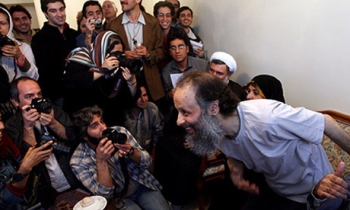Traditionalists devoted to the old Henry Luce idea of a newsweekly may be viewing Time magazine's recent makeover with discomfort, but Madison Avenue is down with the program.
Media buyers praised this week's radical new look for playing up individual voices in the magazine -- brand names which, in turn, are supposed to direct younger readers to the Web.
"The success for magazines and even newspapers these days is going to be how those readers and customers are shared and passed along," says Eric Blankfein, a senior vice president at independent Horizon Media. "They need to blur the line between the online product and a printed product."
This week's audacious redesign is only the latest of a dizzying series of changes at the venerable magazine, a unit of Time Warner's Time Inc. In addition to a new look, editors have invoked the Economist as a role model for the new Time -- less of a news digest, more of an opinion journal. It's a risky strategy for a mass-market magazine: If the appeal is too narrow, circulation could suffer, bringing advertising down with it.
At the beginning of the year, Time began to appear on Friday rather than Monday. Last year it got a new editor, and also shrank its circulation to focus more on class readership than mass readership. It also trimmed its staff, shuttering bureaus, laying off editors and reporters and furthering the gradual dismantling of a longtime caste system of correspondents feeding material to uber-writers in New York. Time, which has had trouble attracting online readers, is under great pressure to perform better on the Web, as are all the Time Inc. publications.
But it is the new look that brings home how dramatic the transformation is. The familiar red-bordered cover remains, but it is adorned with "skyboxes" plugging other stories. Inside is very large print announcing the appearance of columnists such as "Krauthammer" (Charles) and "Klein" (Joe).
The pages are airy, with white space, and there is less news digest and more analysis and perspective, including the cover story depicting Ronald Reagan with a photo-illustrated tear in his eye and the line "How The Right Went Wrong." Future issues will provide lots of directional signals to the magazine's online edition, editors promise.
The reasons for this are obvious. "With the market placing so much emphasis on online opportunities, the newsweekly category just feels old," says Scott Daly, executive media director at Dentsu's Dentsu America.
To be sure, many of the changes are merely speeding up what newsweeklies have been doing for decades, as more-comprehensive newspapers, and then cable TV and the Web, began to invade their turf. And there are still familiar features, albeit packaged differently.
The new Time "has some of the qualities of a monthly, but with a weekly urgency," says Richard Stengel, the magazine's managing editor. He insists that the magazine hasn't abandoned its hard-news franchise. But he believes some of the new things Time is trying "will be attractive to younger readers, but still be appealing to older readers. That's the line we are walking."
There is an opportunity for the new Time to attract "the first generation of the 'My Yahoo' consumer," says Tim Spengler, chief activation officer at Initiative, an Interpublic Group ad-buying firm. That audience is getting older and may be looking for an alternative to "short digestible bits" of news, he adds.
Ad pages at Time in 2006 were down about 23.8% from the magazine's 2000 total, according to Publishers Information Bureau, while rival Newsweek's 2006 pages fell about 17.6% from the 2000 total. In November, Time announced it would cut its rate base, or the circulation it guarantees advertisers, by about 19%, or 750,000, to 3.25 million, and raise its cover price to $4.95. Mr. Stengel says he intends for Time to remain "a mass magazine."
The magazine has also begun to offer advertisers the opportunity to buy ads based on a guarantee of how many people read the magazine, rather than circulation, a maneuver that has divided Madison Avenue. Some media buyers say there has to be a better way to determine the audience of a magazine other than the number of people who pay for it, especially as more people read magazine content via the Internet.
But others feel Time's audience measure, based on research by Mediamark Research Inc., isn't fully fleshed out. Dentsu's Mr. Daly says the idea is "ridiculous" and that the measure as it stands is "questionable." As of March, a Time spokeswoman says, 30% of the magazine's advertisers had agreed to buy based on a guaranteed readership of 19.5 million. One advertiser that says it will be watching is General Motors, which has cut back spending on newsweeklies in recent years. The company wants to see what effect, if any, the new look has on Time's circulation, says a GM spokeswoman.
Placing emphasis on individual writers has taken on new importance at a time when advertisers are paying more attention to the Web. With new editorial formats such as blogs gaining traction, advertisers have begun to see that consumers are eager to follow specific voices and topics, particularly on the Web.
"Over time, news has been as much reflective of the people delivering it as the news itself," says Peter Gardiner, chief media officer at Interpublic's Deutsch. Marketers are also looking for more ad deals from publishers that make use of the Web and print, say media buyers, and editorial product from individual writers can help bolster such opportunities.
Expectations are high among media buyers that Newsweek will now follow suit with its own print redesign, but executives there aren't showing their hand just yet. "With a new editor and a new art director, it's natural for us to be looking at the magazine anew, an ongoing process that's unrelated to what our competition is doing," says a Newsweek spokeswoman.
Write to Brian Steinberg at brian.steinberg@wsj.com









